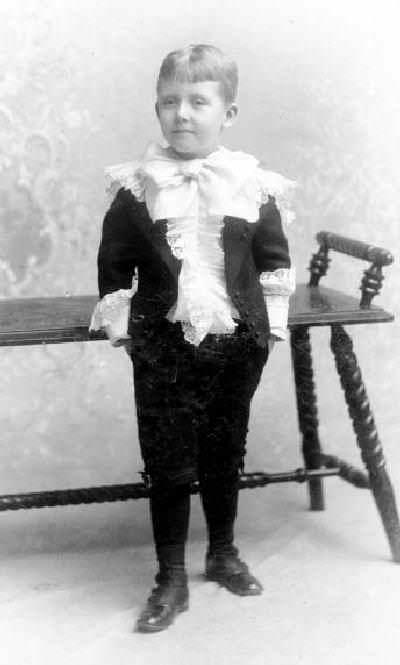
Figure 1.--This Brooklyn New York boy was photographed about 1890 he looks to be avout 8 or 9 years old. Note the fabcy blouse and strap shoes.


Figure 1.--This Brooklyn New York boy was photographed about 1890 he looks to be avout 8 or 9 years old. Note the fabcy blouse and strap shoes. |
Some interesting information is available on Fauntleroy suits, ranging from period fashion articles to biographical information.
Growing kinder to the small boy every season, fashion now furnishes him with garments that are becoming and more suited to his years. Many a sixteen year old boy
of today looks back with horror and disgust on the time 5 and 6 years ago, when fashion dictated that he should be belted in a Russian blouse, and the small boy
of-today thanks his good fortune that the style was only a short-lived one, and had its day before he was out of dresses.
These items describe boyhood preferences concening Fauntleroy suis and other clothes.
Francis Hobson Burnett originally conceived of the Little Lord Fauntleroy story as
a way of entertaining her children. She published the book in 1886. She also
published several other books, the text and illustratins to which include interesting
discritions/illustrations of boys' clothes during the late 19th Century and early 20th
Century. She has two other very famous books. One was The Secret Garden, in
which the rich boy, Colin, is often depicted in a Fauntleroy suit. It has also been
produced in film and TV productions as well as a Broadway musical. Another of
her books was The Little Princess, made into a notable 1930s movie staring
Shirley Temple.
One author describes the desire of Americans in the late 19th Century to emulate English aristocrats, or how they envisioned European aristocrats.
Several important illustrators have illustrated the various editions of Little Lord Fauntleroy. Illustrators from every major European country have illustrated the various national editions of Mrs. Burnett's book. Many of them may well have worn velvet Fauntleroy suits as boys, however as yet I have little background on them. The first edition of Francis Hodgson Burnett's book Little Lord Fauntleroy was illustrated
by Reginald Birch. The image of Little Lord Fauntleroy, Cedric Erol, was largely set by the
Birch drawings. Actual descriptions of costumes were very limited in the book itself. Many
subsequent editions of the book, both Americam, foreign were illustrated by others. None of
these illustrations, however, were to have the influence of Birch's originals. Many used the
Birch drawings as a model. Others came up with a wide variety of fanciful outfits.
This an excellent example of a period Fauntleroy suit worn by a small Canadian boy as his party suit. It was made of a rich burgandy velvet a good example suggesting that many suits that looked like black velvet in black and white photographs. Notice the silk lining and white stockings worn with the suit. Unfortunately we do not know what kind of hat was worn with the suit.
It may be convenient, in this preliminary letter, to follow an English boy through his sartorial career-if yon will excuse, just for once, the detestable adjective. When he is, as we call it, breeched-that is, when he ceases to wear frocks--3. well-to-do child who will presently become a boy is generally put into a velveteen suit, rather of the Fauntleroy order, and wears his hair long, A lace collar, and perhaps cuffs, adorn him, to his discomfort when he meets boys of slightly lower social
status.
Little Lord Fauuntelroy suits have been depicted in a great many movies and television
programs, including several productions of the book itself. The accuracy of the production of the suits and other fashions predicted has varied greatly. This is in part because in several instances well-established child starts such as Freddy Barthomew were used and they had some say in how they were costumed. The child stars in particular seem to have drawn the line at ringlet curls. In addition, because of the image of the book, producers have often sought to downplay the sissy image of velvet suits, lace collars, and long sausage curls.
Some useful articles about Little Lord Fauntleroy are available in:
A very good article on the Little Lord Fauntleroy styles appeared in Life magazine on December 5, 1949. It tells about Frances Burnett and her son Vivian, with a very nice picture of him all dressed up. There are also pictures of other boys who played Cedric on the stage.
Jo Paoletti at the University of Maryland has published an insightful article on Little Lord Fauntleroy suits. The Little Lord Fauntleroy story is an interesting one, and like most fashion tales, not at all superficial. She believes that by examining men's and boys' fashions during the period, we can begin to understand the social conventions that guided
them, the limits of their self-expression, the expectations that they faced, and can
gain some insight into the structure and flavor of their lives. She also believes that the extremes ofthe Fauntleroy style was a factor in the trend toward more practical, casdual styles that appeared after the turn of the 20th century. HBC believes that is a fascinating example of connecting fashion to important societal trends.
Navigate the Boys' Historical Clothing Web Site related pages:
[Return to the Main Fauntleroy page]
[Ringlet curls]
[Vivian Burnett]
[Kilts]
[Long stockings]
[Lace collar]
[Sailor hats]
Navigate the Boys' Historical Clothing Web Site:
[Introduction]
[Activities]
[Bibliographies]
[Biographies]
[Chronology]
[Clothing styles]
[Contributions]
[Countries]
[FAQs]
[Boys' Clothing Home]
